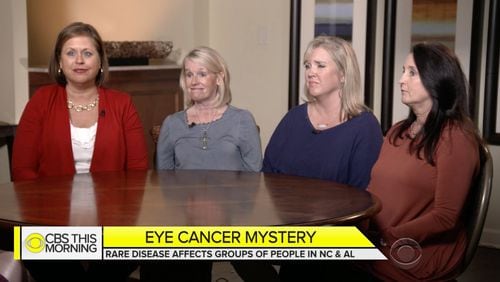It's the health story worthy of a mystery writer: Over 50 people, including more than three dozen who attended Auburn University some two to three decades ago, have been diagnosed with ocular melanoma, a rare form of eye cancer. As doctors and epidemiologists search for possible causes and connections, questions about the cancer and its possible impact in Georgia are swirling. To answer them, the AJC spoke with doctors, health organizations and Auburn alumni here.
Q: What is ocular melanoma?
A: An aggressive form of cancer that develops from the cells that produce melanin (which is responsible for skin color), it's a malignant tumor in the eye that can grow and spread to other parts of the body. "OM is much rarer than skin melanoma and behaves quite differently," according to the Ocular Melanoma Foundation. "It's a potentially lethal disease which many people die from, especially when it spreads to the liver, a complication in about half of people diagnosed with this disease."
Q: How common is it?
A: Not very, although it's the most common primary eye cancer in adults. It occurs in about six of every 1 million people, with about 2,000 adults receiving a diagnosis in the U.S. annually. In Georgia, an average of two new cases were reported annually between 2000 and 2015, according to the state Department of Public Health.
Q: How is it diagnosed and treated?
A: How and why someone gets OM remains unclear, but in some people, a "freckle" — technically, a choroidal nevus — develops at the back of the eye. Some people will experience blurred vision, spots or other symptoms; but for many others, there are no symptoms, and the nevus is detected during a routine eye exam. A smaller percentage of those nevi evolve into a melanoma, seemingly by chance. "It's due to a series of mutations that spontaneously occur in the nevus," said Dr. Hans Grossniklaus, a specialist in diseases and cancers of the eye at Emory Eye Center. "It's by random chance that they occur." Depending on the size of the melanoma and other factors, treatment may include radiation, resection (removing the tumor) or full removal of the affected eye.
Q: Why is OM suddenly in the news?
A: Despite its relative rarity, OM has been diagnosed in more than 50 people in and around two locations: Huntersville, N.C., and Auburn, Ala. Overall, 38 of the diagnosed patients report having attended Auburn University between 1983 and 2001, including three women who were close friends there (one of them, Ashley McCrary, started the Auburn Ocular Melanoma page on Facebook, leading others to come forward). Of the 18 cases in Huntersville, a town of some 55,000 people located north of Charlotte, three went to the same high school there. What's more, nine of the first 12 patients identified in Huntersville were female and six were younger than 30 when diagnosed, according to the Charlotte Observer. The situations appear to be somewhat atypical when it comes to OM:
"It's a little more common among men and it's age-related," said Grossniklaus, the senior professor of ophthalmology at Emory University School of Medicine. "Between 50 and 60 is the age at which it's typically diagnosed."
Q: What’s caused these cases and are they all connected?
A: No one knows for sure yet. Dr. Marlana Orloff, a Philadelphia oncologist who's treating some of the Alabama patients, told CNN that no common cause has been identified in these cases. Referring to the affected areas as cancer "clusters" is premature and could turn out to be erroneous: "That has a strict definition as far as epidemiology goes," said Dr. Stephen M. Hamilton, an Atlanta ophthalmologist/surgeon and Auburn graduate who's closely following the OM developments. Indeed, while people have posited all sorts of possible links and causes, including long-ago use of cosmetics or tanning beds by the Auburn patients, a thorough epidemiological study would be required to rule out randomness or coincidence. "It would involve mapping out cases, figuring out what the similarities are and getting data over months or years," Grossniklaus said of such epidemiological investigations. "Reaching back in time and asking where did they live, what was the water supply at the time, what fertilizer was used, etc. It's looking at a lot of different things to figure out if they're all related and what the commonalities are to determine that there's any causal relations."
Q: What’s happening in Georgia and what should people here do?
A: So far, nothing similar to the situations in North Carolina and Alabama appears to be occurring here. Doctors and other experts here report hearing about no "pockets" or significant upticks in OM cases; several posts about it on the Atlanta Auburn Club's Facebook page have resulted in plenty of shares, but no comments about known cases in Georgia. There are currently 33,810 Auburn alumni living in Georgia, according to the Auburn Alumni Association. In February, Hamilton (class of 1984) commented on the club's Facebook page that everyone who went to Auburn in the 1980s and 1990s should get eye exams and offered his services. "I've probably seen about a half-dozen people, none that had any positive findings," said Hamilton of Eye Consultants of Atlanta. Still, he expects the number seeking checkups to increase as the news about OM continues to spread. In fact, Grossniklaus recommends all adults have routine eye exams every two years, increasing that to once a year after age 50.
About the Author






